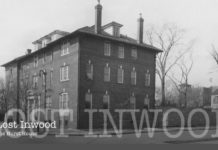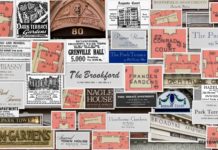
The citizens of Inwood were up in arms during the summer of 1900. An injustice of historic proportions was in play. An aging neighborhood landmark, the former Nagle homestead, commonly referred to as “The Century House,” was threatened with destruction.

The two-story home, with the low, pointed roof sat near the bank of the Harlem River, near the present West 213th Street, in the middle of a planned roadway.
The structure was marked for demolition. Progress said some.
But not if a group of early Inwood historic preservationists could prevent the old home’s demolition.

Even at the turn of the twentieth century New Yorkers were sickened to see so many important old buildings vanish into the modern landscape—The Century House was, after all, a tangible connection to Manhattan’s early settlement.
Jan Nagle II, whose father had been one of the region’s founding fathers, built the home in 1736. The home predated the nearby Dyckman House by nearly fifty years.
During the Revolutionary War, three of Nagle’s sons, all lifelong bachelors, occupied the home.

“We may conclude that the family remained at their home during that ruthless period,” wrote historian Reginald Pelham Bolton, “and, probably by reason that officers were quartered there, managed to preserve their property from the destruction that befell others.” (Washington Heights, Manhattan: Its Eventful Past, Bolton, 1924)
There are reports that General William Heath made the house his headquarters prior to the fall of nearby Fort Washington.

The dwelling figured so much into local lore that the preservationists explored possibility of relocating the structure.
But masonry was heavy lifting and the home’s timbers were terribly decayed. The house would not likely survive a move.

“Road be damned,” cried the preservationists. Why not build a park around the home?
“This would give the people of the neighborhood a breathing spot near the river, and the scheme would make the destruction of the house unnecessary,” wrote the New York Tribune, “besides making the little park attractive because of its antique centerpiece.” (New York Tribune, August 12th, 1900)
And what a quaint centerpiece the Century House would have been.

“It faced south,” wrote Bolton, “ a broad piazza extending across the front, and had two floors, the upper one a half-attic with a row of little windows looking out under the eaves. The interior was about thirty-six feet wide by eighteen feet deep.” (Washington Heights, Manhattan: Its Eventful Past, Bolton, 1924)

The walls of the cellared home were two and a half feet thick and constructed of local rock and stray bricks. The mortar that held the house together was a mix of oyster shells, lime and even bits of animal bones and lobster claws.
A circular staircase that led to the attic contained a secret hiding spot accessible only by pulling a knob wood carved into the half landing.
Heavy chestnut doors and shutters hung from hand-forged hinges.

“There is no particular historical reason for advocating the preservation of this old house,” conceded the Tribune scribe, “unless, like every other house a hundred of more years old, it was the only original, Simon pure ‘Washington’s headquarters;’ but it should be restored as one of the best specimens of pre-Revolutionary architecture.” (New York Tribune, August 12th, 1900)

Sadly, the Century House was destroyed by fire in 1903.









I believe the cornerstone of the century house is on display in the Dykman House